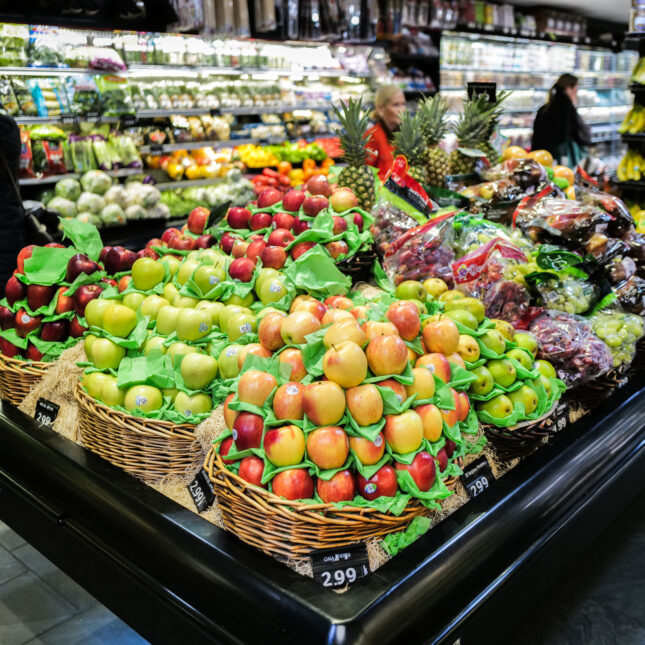
I usually do my grocery shopping at the end of the day when I am tired, stressed, and hungry. In a word, I am vulnerable. The sugary beverages, candy, baked goods, and salty snacks located at the front entrance, aisle end caps, and checkout lanes can be hard to resist. The food industry knows this about me — and you. But small changes in the “choice architecture” can help people avoid these unplanned impulse purchases and choose healthy foods.
Grocery stores, convenience stores, and other food retailers are built to promote sales of cheap, energy-dense, nutrient-poor food and beverages. While these marketing practices target all shoppers, they have the largest effect on low-income shoppers. And much like the tobacco industry, the food industry targets racial and ethnic minority groups and shoppers using Supplemental Nutrition Assistance Program (SNAP) benefits.
These ubiquitous food environments undermine nutrition-related health and health equity goals. Despite exciting new breakthrough treatments, the rates of obesity and diabetes continue to rise, particularly among racial and ethnic minority groups. Dialing back those rates won’t occur without changing food environments.
One strategy is to place healthy food and beverages in highly visible and accessible locations. About 10 years ago, several colleagues and I implemented traffic light labels (green=healthy; yellow=less healthy; red=unhealthy) and healthy choice architecture in the cafeteria at Massachusetts General Hospital, where we worked. We tracked all cafeteria sales for three months, and then labeled all food and beverages with red, yellow, or green labels. After three months of labels, we moved many of the healthy items to be at eye level and in convenient locations — think water bottles at every food station.
The result? Hospital visitors and employees increased and sustained healthy food choices over a two-year period. Since then, our team and others have demonstrated that architecture that promotes healthier choices is effective in a variety of retail settings, including low-income communities.
While some supermarkets have voluntarily implemented health-promoting programs — the Guiding Stars system used in Hannaford grocery stores is an example — these efforts are sporadic and not coordinated. Policies are needed to ensure that a healthy food environment is equitably available in all stores and communities.
In 2021, the city of Berkeley, California, took an important step in this direction with a first-of-its-kind healthy checkout ordinance. Supermarkets and other large stores were required to limit the types of food and beverages in stores’ checkout lanes to include only unsweetened beverages and foods with minimal added sugars or sodium. A study of this policy that was published Thursday in JAMA Network Open demonstrated that within one year, Berkeley stores had an impressive 125% increase in healthy food and beverage checkout lanes. Although Berkeley may not be representative of many cities, this experience clearly shows that a city-wide healthy-checkout policy is feasible and effective.
To be sure, healthy checkout policies by themselves aren’t likely to change the diet or health of most people. That will take multi-level policies that affect different aspects of the food environment. Fortunately, there are three evidence-based food environment policies that, if implemented broadly, could significantly change the U.S. food environment and improve Americans’ health.
First, the impact of healthy placement policies is supported by more than a decade of research. Stocking healthier options in checkout lanes, aisle endcaps, and front-of-store locations helps shoppers make healthier choices. In Berkeley, large supermarkets, mass merchandisers, and other chain stores had the highest compliance with the checkout policy, suggesting the potential for national scalability. With more than 250,000 SNAP-authorized retailers in the U.S., standard healthy placement policies for SNAP retailers could have a large public health impact, improving food purchases of all customers without interfering with freedom of choice.
Second, simple and easily visible labels on the front of packaged foods also help consumers make healthier choices. Following publication of the White House National Strategy on Hunger, Nutrition, and Health in September 2022, the Food and Drug Administration is considering a variety of strategies, including traffic lights, guiding stars, and warning labels, for a possible standardized front-of-package labeling system.
Third, policies to tax sugar-sweetened beverages — which are a major contributor to obesity and cardiovascular disease— have been implemented in some U.S. cities. Philadelphia, for example, imposes a 1.5-cents-per-ounce tax on sugar-sweetened and artificially sweetened beverages. Two years after its initiation, taxed beverage sales decreased by at least 35%.
Local and national policies to improve the food environment are important. But the food industry must also contribute by innovating healthier products (low in added sugars, sodium, and unhealthy fats) that are also affordable. Implementation of healthy placement standards and front-of-package labeling could nudge manufacturers to reformulate products to align with healthy food policies, though it will be important to monitor unintended consequences, such as new marketing strategies aimed at circumventing regulations.
Almost everyone is vulnerable to unhealthy food environments. The odds that the food industry will voluntarily improve its choice architecture is slim to none. That leaves cities, states, and the federal government to take action by implementing evidence-based policies to support and sustain healthier food choices by all Americans.
Anne N. Thorndike, M.D., M.P.H., is a primary care physician in the Division of General Internal Medicine at Massachusetts General Hospital in Boston and an associate professor of medicine at Harvard Medical School.
LETTER TO THE EDITOR
Have an opinion on this essay? Submit a letter to the editor here.
To submit a correction request, please visit our Contact Us page.










STAT encourages you to share your voice. We welcome your commentary, criticism, and expertise on our subscriber-only platform, STAT+ Connect